Scientific Classification
Species in the Genus
Species in Kenya, Tanzania & Uganda
Description
Possible Causes of Confusion
Distribution in Kenya, Tanzania & Uganda
Habitats
Nesting
Crops Visited
Other Plants Visited
Economic / Ecological Importance
Threats
Conservation and Management Practices
Legislation (National and International)
References
Editors
Acknowledgements
Contact
Click on images to enlarge
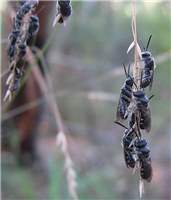
Lasioglossum species. Photo by John Tann (CC BY)
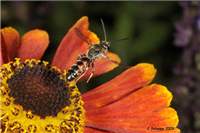
Lasioglossum species. Photo by Gustavo Fotoopa (CC BY-NC-ND)
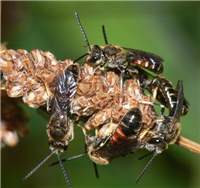
Lasioglossum species. Photo by bramblejungle (CC BY-NC)
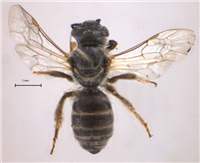
Lasioglossum species (female) - pinned specimen. Photo: Connal Eardley
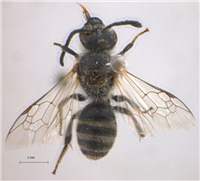
Lasioglossum species (male) - pinned specimen. Photo: Connal Eardley
Summary
Honey bees are not the only bee species that are significant for human wellbeing. Lasioglossum bees are a group of native bee species that do not produce honey but are important pollinators of crops and wild plants. These small black bees are not aggressive but can sting for defence. They have a mild sting that is much less painful than that of a honey bee.
They live independently of others (i.e. they are solitary) or in small groups and build their nests in the ground. This fact sheet provides information about these bees to encourage farmers to understand and protect them to help ensure that their crops are effectively pollinated.
From a conservation and agricultural standpoint it is not necessary to recognise all the different bee genera. However, it is important to know that there is a large bee biodiversity. Different bee genera pollinate different plant species, although there is some overlap that acts as a buffer as bee populations wax and wane. For healthy ecosystems, including agro-ecosystems both diversity and abundance in the bee fauna is important.
Common Name (Language)
Sweat bees, mining bees (English)
Scientific Classification
Kingdom: Animalia
Phylum: Arthropoda
Class: Insecta
Order: Hymenoptera
Family: Halictidae
Subfamily: Halictinae
Tribe: Halictini
Genus: Lasioglossum Curtis, 1833
Species in the Genus
About 280 species from all over the world have been described from this genus, making Lasioglossum one of the bee genera with the highest number of species. In
Species in Kenya, Tanzania & Uganda
Over 30 Lasioglossum species have been recorded in
Description
Lasioglossum bees are not well known by local people (including farmers) in
Possible Causes of Confusion
These bees can be confused with some flies that have similar black colouring and size. Flies can be distinguished from Lasioglossum bees in that they have only two wings while bees have four wings. These bees are very closely related to those in the genera Halictus and Patellapis. Lasioglossum bees can be distinguished from Halictus species which are metallic but Lasioglossum and Patellapis species may be difficult to distinguish from each other apart from under a microscope.
Distribution in Kenya, Tanzania & Uganda
There is little information about the distribution of these bees within the
Habitats
Lasioglossum bees can be found in all agricultural habitats (agro-ecologies) and natural habitats in the East African region extending from the low coastal lands to the highlands. Representative species can be found both in dry and wet lands.
Nesting
These solitary bees construct their nests in soils.
Crops Visited
These bees are known to visit crop plants in the families; Asteraceae (Compositae) e.g. sunflowers, Convolvulaceae (e.g. sweet potato), Cucurbitaceae (e.g. cucumbers and melons), Liliaceae (e.g. asparagus), Malvaceae (e.g. okra), Papilionaceae (the pea family) and Rosaceae (e.g. strawberries).
Other Plants Visited
Wild relatives of the crop families listed above are visited by these bees. There is also a wide range of plants belonging to many different families that provide pollen to Lasioglossum bees in natural habitats.
Economic / Ecological Importance
Little information exists on the usefulness of these bees to the lives of the people in
Threats
In
Conservation and Management Practices
There are now concerted research efforts in the region to develop best practices for conservation and management of bees that are compatible with other good farm practices, to enhance crop production. Theoretically, bee conservation and management is inexpensive and adopted activities can also improve the aesthetic value of the landscape. Such practices involve setting land aside (e.g. a 1-metre strip) in the farmland to host all year round food resources for the bees, as well as safer sites for nesting, mating, resting and refuge from natural enemies. During flowering, farmers should manage pesticide usage carefully to avoid poisoning flower-visiting bees. Farmers should also minimise pesticide drift from the field to adjacent areas. Laws governing registration and use of plant protection products indirectly play a major role in the protection of pollinators. Trampling by people and livestock and tilling should be managed to conserve the nesting sites of soil-nesting species such as Lasioglossum bees. KARI (the Kenya Agricultural Research Institute) is developing protocols for mass rearing of different species of solitary bees. Any successful results from this research will be freely communicated to the public. In addition, KARI is collaborating with other stakeholders to ensure in situ conservation and management of bees for pollination purposes. Much of the work of conserving native bees will be underpinned by raising public awareness of the importance of these species.
Legislation (National and International)
There is not yet any legislation in
References
1. Eardley CD and Urban R (2010). Catalogue of Afrotropical bees (Hymenoptera: Apoidea: Apiformes). Zootaxa, 2455: 1–548.
2. Kasina M, Kraemer M, Martius C, Wittmann D (2009) Farmers' knowledge of bees and their natural history in Kakamega district, Kenya. Journal of Apicultural Research, 48 (2): 126-133
3. Lasioglossum species: http://www.cedarcreek.umn.edu/insects/album/025066016ap.html. Accessed March 2011.
4. Martins DJ (2008) Pollination observations of the African Violet in the Taita Hills, Kenya. J EA Nat Hist 97 (1): 33-42
5. Michener CD (1974) The social behaviour of the bees. Belknap Press, Cambridge, USA
6. Michener CD (2007) The Bees of the world, the John Hopkins University Press, Baltimore and London, pp 913.
7. Schmidt J O and Schmidt P J (1986) A Nesting Aggregation of Lasioglossum kinabaluense Michener in Borneo (Hymenoptera: Halictidae). Journal of the Kansas Entomological Society, Vol. 59, No. 4 (Oct., 1986), pp. 672-674.
Editors
Théodore Munyuli, Busitema University - Uganda; Muo Kasina, Kenya Agricultural Research Institute (KARI) - Kenya; Juma Lossini, Tropical Pesticides Research Institute (TPRI) – Tanzania; John Mauremootoo, BioNET-INTERNATIONAL Secretariat – UK; Connal Eardley, Plant Protection Research Institute (PPRI) – South Africa.
Acknowledgements
We recognise the support from the Kenya Agricultural Research Institute (KARI), Tropical Pesticide Research Institute (TPRI) –
Contact
BioNET-EAFRINET regional coordinator: [email protected]












